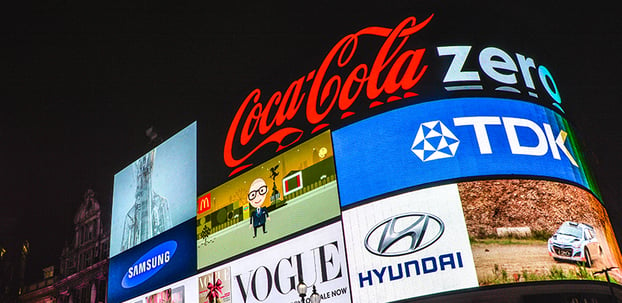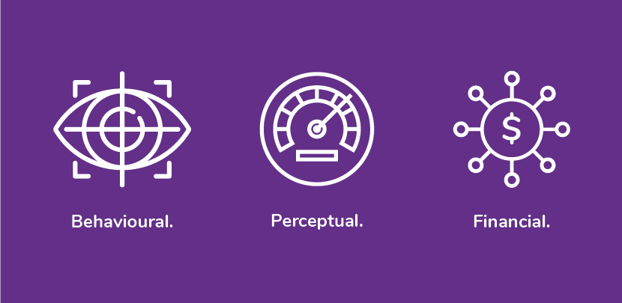A healthy brand is a profitable brand, but what does ‘healthy’ look like and how can a brand track, manage and capitalise on it?
This complete guide reveals the what, why and how of tracking brand health, including the metrics and methodologies you should focus on to gain actionable insights for your brand strategy.
Short on time? Download a copy of this guide to read offline

Before we can understand what a healthy brand is, it's important to understand what a brand is. There are many definitions of ‘brand’. Advertising tycoon, David Ogilvy, defined it as “the intangible sum of a product’s attributes”. Some experts say it’s more about the customer’s perception of a product, service or company. Others refer to more concrete matters such as logos, taglines and imagery.
All of these definitions are correct, but they don’t quite capture the entirety of the term.
Allan Dib, marketing strategist and best selling author, has a useful way of thinking about it: consider your company’s brand as a ‘personality’ and the way the market sees your brand forms part of that personality.
This might include:
Much like human personalities, the personalities of two brands can vary a great deal. For example, PAK’nSAVE has a very different brand personality compared to New World: the former uses a decidedly ‘low budget’ stick-figure across their advertising and marketing, whereas New World emphasises their in-store experts, including the ‘Master Butcher’, ‘Fishmonger Genius’ and ‘Dedicated Bag Packer’. Value versus quality, expressed through the way they speak to their customers.
“It’s important to remember that a significant part of ‘brand’ isn’t defined by the company that it belongs to, but rather where it sits in the mind of their customers,” explains Oliver Allen, General Manager at Perceptive.
If a brand is a company’s personality, then a healthy brand is a personality that helps the company consistently achieve its goals.
What is defined as “healthy” depends on the outcomes the company wants. Two completely different companies in different industries can both be considered healthy, even if they are on opposite ends of the spectrum on their brand metrics—as long as they are performing well in the metrics that matter for them.

Just a few decades ago, most businesses would only have to compete with a few other major players in their industry—today, that’s closer to dozens, even hundreds in some industries. Even local brands now have to compete with global players that weren’t a consideration 10 years ago.
Now more than ever, a company needs a strong and healthy brand to distinguish themselves and compete for a share of their target market.
Tracking brand health isn’t about vanity metrics. It’s about developing an all-encompassing picture of your company, allowing you to make smarter, more profitable decisions.
It allows you to develop a map of opportunities from ways to differentiate the brand, expand brand awareness and influence brand preference to increasing purchases and delighting customers. It’s not just about a score—it’s about the insights that explain that score.
For example, as part of their regular brand health tracking programme from Perceptive, Burger King (BK) uncovered there was a gap between the desired perception of their brand and the actual perception of their brand. People didn’t believe that BK burgers were flame-grilled. This lead to the development of the successful “Backyard BK” advertising campaign, emphasising BK’s unique flame-grilled flavour.
This insight-led campaign helped fuel one of BK’s strongest financial years ever. Read the full case study.
Brands are constantly evolving. The daily push and pull of companies’ marketing activities and customer interactions create waves that affect your audience’s perceptions and decisions. When a competitor changes their brand narrative, this can affect how your audience perceives you.
“It doesn’t even need to be a competitor,” explains Oliver Allen.
“Think about how Uber and Airbnb have changed the expectations customers have and how they engage with a service. Other industries now have to live up to these expectations, even if they aren’t direct competitors with those services.”
The constant need to keep a pulse on your brand’s positioning and performance is inescapable. However, there are some key events that should trigger a deeper brand audit, including:
Example
Until recently, New Zealand was dominated by two major brands: Life Pharmacy and Unichem, both of which were owned by the same corporate entity. However, over the course of a couple of years, two new major competitors entered the market, offering a completely different brand experience.
This created a challenge for the existing players—prompting a need to review how the market now perceived them and whether they would need to change their brand strategy entirely to adjust for this new threat.
Similarly, Spark was challenged by the entry of 2degrees into the market; an entire telco born out of the idea that they weren’t an established big corporate.
This prompted a brand health check and an evaluation of how to deal with this new, successful competitor. This came in the form of Skinny Mobile, another grassroots telco backed by Spark. Spark knew from its brand tracking efforts that they would not be able to ‘stretch’ their existing brand into this new grassroots niche. So they created a new brand that could.

Most measures of brand health will fall into one of three categories:
Which measures a company chooses to invest in will largely depend on its overall business goals. A high-growth company with capital to spare might not be as interested in financial metrics as they may be with perceptual metrics. It’s more important to know whether the intended message is landing and the impact of that message than simply how much revenue that message is generating.
Here are a few of the methodologies we leverage at Perceptive:
The brand conversion funnel (or just ‘brand funnel’) is used to measure how a brand is performing at the different stages of the customer journey. These stages are in the following order:
For example, Apple Inc. might be struggling to convert people from Consideration to Preference. From previous brand health studies, perceptual metrics show that their brand is considered stylish, innovative, and generally ‘cool’; achieving high for awareness and consideration.
It could be that while emotive associations of the brand are strong, the functional associations are lacking: perhaps the products are not considered good value for money, or they don’t integrate with the existing technology of the purchaser.
Learn more: What are the brand tracking KPIs for a brand manger to monitor?
Understanding the premium a brand can command over its competitors is useful even if the brand isn’t being valued for sale: it’s a useful measure when raising funds, licensing and, of course, when trying to understand the financial performance of a brand.
Most (if not all) brand valuation methodologies fall into one of three general categories:
This method is effective in trying to put a physical number on a brand, but there are drawbacks in terms of each method being almost purely hypothetical: until you actually physically sell the brand, it is difficult to consider every single aspect that could affect its market value or revenue-generating value.

Lastly, there is the consideration of pure customer opinion. In this arena, you’ll often hear “word of mouth” and “social listening”. Customer feedback, customer sentiment, customer ‘love’: these are all names for the same general principle of asking customers directly how they feel about a brand and identifying key themes from the responses. These provide a strategic overview of where your brand is performing well and where the brand promise is yet to be delivered.
Perceptive uses a number of customer centric metrics to measure customer sentiment including:
Learn more: 7 benefits of NPS: why use it over other customer satisfaction tools?
RFM is a form of customer value modelling (CVM) that is used to measure and segment a business’ customer base by purchase behaviour. It is a useful measure for brand health because it provides practical insight into how different customer segments are interacting with your brand from a purely transactional perspective. Brand perceptions within each customer segment can then be analysed more closely and influenced at a targeted level.
RFM is named after the measures that it is made of: recency, frequency and monetary:
Unlike other models listed here, the RFM model is used as a way of building on already established customer insights rather than necessarily being used to gather new information on pure brand health. Use it in conjunction with other models for best results.
Learn more: RFM modelling: a powerful customer segmentation tool
There are several methods to obtain both qualitative and quantitative brand data and start to measure the healthiness of a brand. Some of our favourites include:
And many more, all of which are designed to make the intangible, tangible. The methods that you use, again, will depend on your company goals. Many businesses like to use the Net Promoter Score to better understand how their brand is perceived by customers. Others benefit from social listening to discover what people (not necessarily customers) are saying about the brand to their friends, family and followers.
“Social listening allows brands to eavesdrop or dial into the conversations consumers are having about them in the social sphere. This can be very useful in understanding how people feel about your brand, your communications or your products and services. Monitoring this and leveraging it as a brand development tool can be very effective,” explains Oliver.
Before you get started, answer these questions to assess the current state of your brand:
If you’re planning to start monitoring your brand, track brand performance or change your brand tracker, there are certain things you want to check.
One of the most important things to be aware of is that your brand tracker should inform all of your brand and marketing activity. A good brand tracker should be able to tell you what to do, where to go and, most importantly, why.
When you’re in the market to invest in a new brand tracker, check that it has the following features.
These features allow you to get a birds-eye view of what the market is thinking, which allows you to devise strategies to lead your brand. At Perceptive, our brand tracker has all of these features.
Historically, brand tracking has been retrospective. You’d get information on what has happened, not what’s happening right now—or what you need to do to get a particular result in the future.
Intuitive trackers smooth out “knee-jerk reactions” in the market. When you can track the market over time, and see trends and real-time activity, you will get cleaner insights which allow you to respond in a less volatile manner. The information you are provided is actual trends—not just small spikes that you are notified of after the fact.
At Perceptive, our brand tracker is always on. The data that comes through is as fresh and up-to-the-minute as possible, which allows your business to be more proactive and more competitive.
Take control of your brand health now by getting in touch with one of our brand research experts.